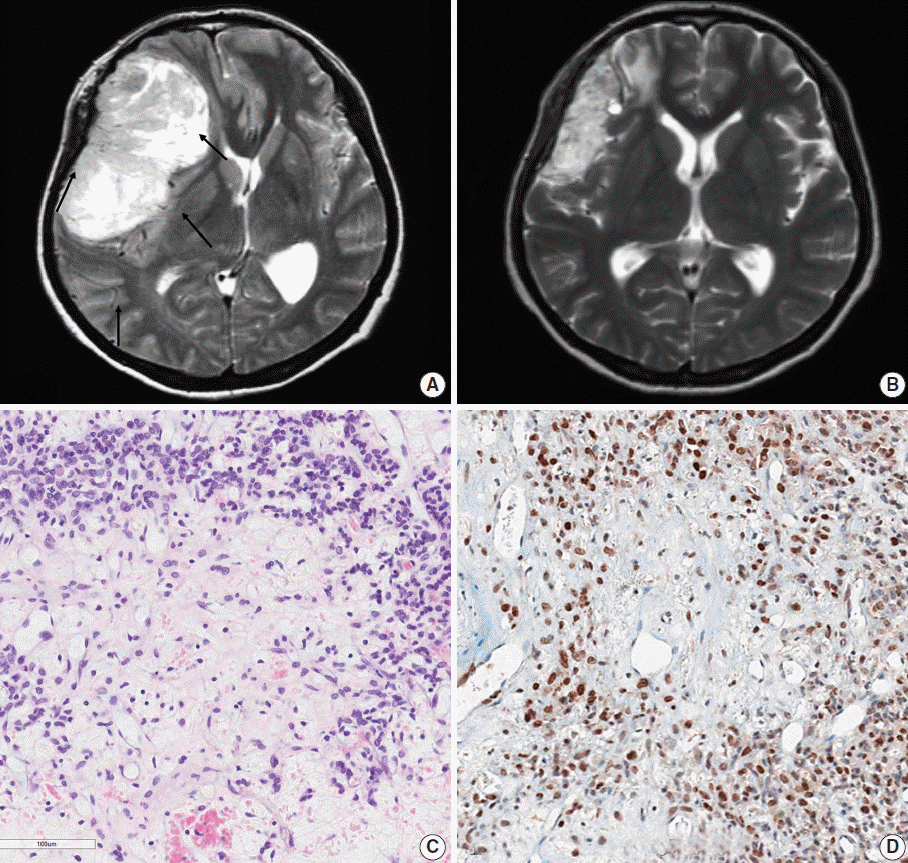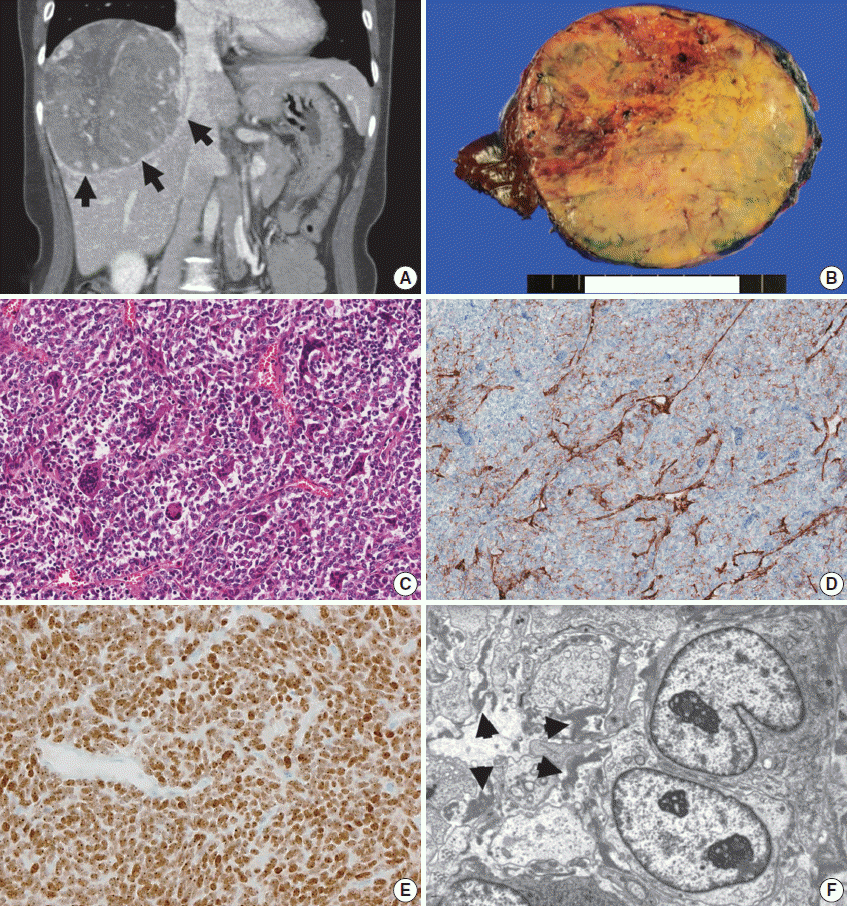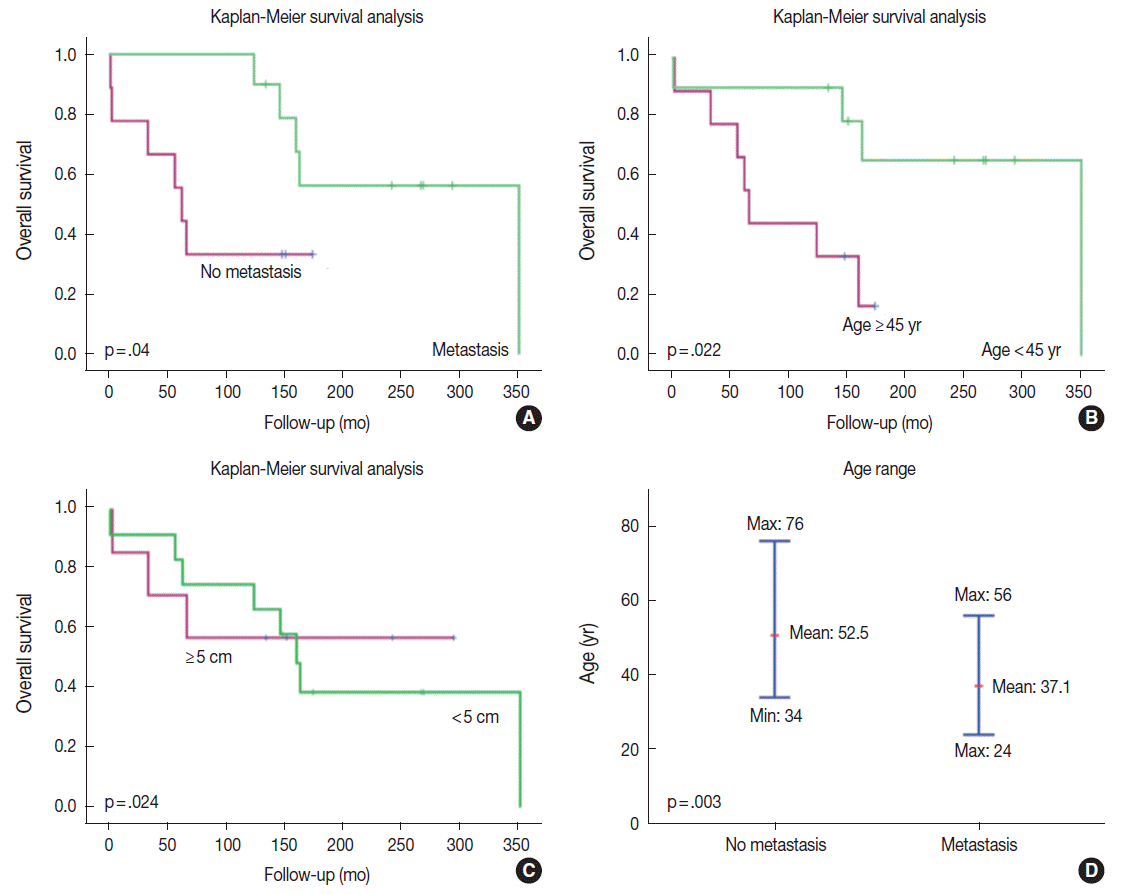Articles
- Page Path
- HOME > J Pathol Transl Med > Volume 50(2); 2016 > Article
-
Original Article
Meningeal Solitary Fibrous Tumors with Delayed Extracranial Metastasis - Nayoung Han1,*, Hannah Kim1,*, Soo Kee Min2, Sun-Ha Paek3, Chul-Kee Park3, Seung-Hong Choi4, U-Ri Chae5, Sung-Hye Park1,6
-
Journal of Pathology and Translational Medicine 2016;50(2):113-121.
DOI: https://doi.org/10.4132/jptm.2015.10.30
Published online: December 14, 2015
1Department of Pathology, Seoul National University College of Medicine, Seoul, Korea
2Department of Pathology, Hallym University Sacred Heart Hospital, Hallym University College of Medicine, Anyang, Korea
3Department of Neurosurgery, Seoul National University College of Medicine, Seoul, Korea
4Department of Radiology, Seoul National University College of Medicine, Seoul, Korea
5Department of Industrial Engineering, Ajou University, Suwon, Korea
6Neurosicence Institute, Seoul National University College of Medicine, Seoul, Korea
- Corresponding Author: Sung-Hye Park, MD Department of Pathology, Seoul National University College of Medicine, 103 Daehak-ro, Jongno-gu, Seoul 03080, Korea Tel: +82-2-740-8278 Fax: +82-2-765-5600 E-mail: shparknp@snu.ac.kr
- *Nayoug Han and Hannah Kim contributed equally to this work.
© 2016 The Korean Society of Pathologists/The Korean Society for Cytopathology
This is an Open Access article distributed under the terms of the Creative Commons Attribution Non-Commercial License (http://creativecommons.org/licenses/by-nc/3.0/) which permits unrestricted noncommercial use, distribution, and reproduction in any medium, provided the original work is properly cited.
Figure & Data
References
Citations

- High-grade, metastatic disease, and adjuvant radiotherapy are independent prognostic factors for progression-free survival in patients with solitary fibrous tumors
Jan Paul Alker, Ramin Rahmanzade, Thomas Held, Christel Herold-Mende, Andreas Unterberg, Felix Sahm, Sandro Manuel Krieg, Gerhard Jungwirth
Neuro-Oncology Advances.2025;[Epub] CrossRef - Meningeal malignant solitary fibrous tumor with multiple recurrence, extracranial extension, cervical lymph node metastases: case report and review of the literature
Rong He, Peng Zhong, Juntao Hu, Guangkuo Guo, He Xiao, Lin Lei, Yun Liu, Mingying Geng, Jungang Ma
Discover Oncology.2025;[Epub] CrossRef - A Case of Intracranial Solitary Fibrous Tumor Followed by Distant Metastasis without Local Recurrence
Masafumi YOSHIDA, Koki MORIYOSHI, Kento DOI, Yukihiro YAMAO, Natsue KISHIDA, Hiroya UEMURA, Shunichi FUKUDA
NMC Case Report Journal.2025; 12: 181. CrossRef - The association between WHO grading and the long-term outcomes and radiotherapy efficacy of intracranial solitary fibrous tumors
Leihao Ren, Lingyang Hua, AO Feng, Jiaojiao Deng, Hiroaki Wakimoto, Tareq Juratli, Qing Xie, Ye Gong
Acta Neuropathologica Communications.2025;[Epub] CrossRef - Meningeal Solitary Fibrous Tumor: A Single-Center Retrospective Cohort Study
Siyer Roohani, Yasemin Alberti, Maximilian Mirwald, Felix Ehret, Carmen Stromberger, Soleiman Fabris Roohani, Katja Bender, Anne Flörcken, Sven Märdian, Daniel Zips, David Kaul, Manish Charan
Sarcoma.2024; 2024: 1. CrossRef - De-differentiation associated with drop metastasis of a recurrent intracranial solitary fibrous tumor: a case report and literature review
Chenhui Zhao, Xiran Fan, Wanwan Gao, Fan Zhang, Haijun Lv, Xiaochun Jiang, Guangfu Di
International Journal of Neuroscience.2022; 132(8): 843. CrossRef - Long-term extracranial metastatic relapse of an intraventricular solitary fibrous tumor: a case report
Tarek Assi, Elie Samaha, Hussein Nassereddine
Anti-Cancer Drugs.2022; 33(1): e764. CrossRef - Multidisciplinary Treatment of Liver Metastases from Intracranial SFTs/HPCs: A Report of Three Consecutive Cases
Felix J. Krendl, Franka Messner, Gregor Laimer, Angela Djanani, Andreas Seeber, Georg Oberhuber, Dietmar Öfner, Dominik Wolf, Stefan Schneeberger, Reto Bale, Christian Margreiter
Current Oncology.2022; 29(11): 8720. CrossRef - A review of solitary fibrous tumor/hemangiopericytoma tumor and a comparison of risk factors for recurrence, metastases, and death among patients with spinal and intracranial tumors.
Enrico Giordan, Elisabetta Marton, Alexandra M. Wennberg, Angela Guerriero, Giuseppe Canova
Neurosurgical Review.2021; 44(3): 1299. CrossRef - Intracranial Solitary Fibrous Tumor of the Skull Base: 2 Cases and Systematic Review of the Literature
Sricharan Gopakumar, Visish M. Srinivasan, Caroline C. Hadley, Adrish Anand, Marc Daou, Patrick J. Karas, Jacob Mandel, Shankar P. Gopinath, Akash J. Patel
World Neurosurgery.2021; 149: e345. CrossRef - Hemangiopericytoma/Solitary Fibrous Tumor in the central nervous system. Experience with surgery and radiotherapy as a complementary treatment: A 10-year analysis of a heterogeneous series in a single tertiary center
Pedro Miguel González-Vargas, José Luis Thenier-Villa, Pablo Sanromán Álvarez, Alexandre Serantes Combo, Lourdes Calero Félix, Raúl Alejandro Galárraga Campoverde, Eva Azevedo González, Álvaro Martín-Gallego, Rosa Martínez-Rolan, Adolfo de la Lama Zaragoz
Neurocirugía.2020; 31(1): 14. CrossRef - Hemangiopericytoma/Solitary Fibrous Tumor in the central nervous system. Experience with surgery and radiotherapy as a complementary treatment: A 10-year analysis of a heterogeneous series in a single tertiary center
Pedro Miguel González-Vargas, José Luis Thenier-Villa, Pablo Sanromán Álvarez, Alexandre Serantes Combo, Lourdes Calero Félix, Raúl Alejandro Galárraga Campoverde, Eva Azevedo González, Álvaro Martín-Gallego, Rosa Martínez-Rolan, Adolfo de la Lama Zaragoz
Neurocirugía (English Edition).2020; 31(1): 14. CrossRef - Solitary fibrous tumor/hemangiopericytoma: treatment results based on the 2016 WHO classification
Kyoung Su Sung, Ju Hyung Moon, Eui Hyun Kim, Seok-Gu Kang, Se Hoon Kim, Chang-Ok Suh, Sun Ho Kim, Kyu-Sung Lee, Won Seok Chang, Jong Hee Chang
Journal of Neurosurgery.2019; 130(2): 418. CrossRef - Grading of meningeal solitary fibrous tumors/hemangiopericytomas: analysis of the prognostic value of the Marseille Grading System in a cohort of 132 patients
Nicolas Macagno, Rob Vogels, Romain Appay, Carole Colin, Karima Mokhtari, Benno Küsters, Pieter Wesseling, Dominique Figarella‐Branger, Uta Flucke, Corinne Bouvier
Brain Pathology.2019; 29(1): 18. CrossRef - Solitary fibrous tumor of the pineal region with delayed ectopic intracranial metastasis: A case report and review of the literature
Yongjie Wang, Jingying Zhang, Qichang Liu, Fuyi Liu, Xiangdong Zhu, Jianmin Zhang
Medicine.2019; 98(21): e15737. CrossRef - Case report: neonatal giant forehead hemangiopericytoma with a 5-year follow-up
AiJun Peng, LiBing Zhang, Hai Zhao, LiangXue Zhou
Medicine.2019; 98(47): e17888. CrossRef - Liquid Biopsy in Rare Cancers: Lessons from Hemangiopericytoma
Chiara Nicolazzo, Luciano Colangelo, Alessandro Corsi, Guido Carpino, Angela Gradilone, Chiara Sonato, Cristina Raimondi, Eugenio Gaudio, Paola Gazzaniga, Walter Gianni
Analytical Cellular Pathology.2018; 2018: 1. CrossRef - Surveillance for metastatic hemangiopericytoma-solitary fibrous tumors-systematic literature review on incidence, predictors and diagnosis of extra-cranial disease
Tarini Ratneswaren, Florence Rosie Avila Hogg, Mathew Joseph Gallagher, Keyoumars Ashkan
Journal of Neuro-Oncology.2018; 138(3): 447. CrossRef - Intracranial Solitary Fibrous Tumor
Eveline Claus, Patrick Seynaeve, Jeroen Ceuppens, Alain Vanneste, Koenraad Verstraete
Journal of the Belgian Society of Radiology.2017;[Epub] CrossRef - Comparison and evaluation of risk factors for meningeal, pleural, and extrapleural solitary fibrous tumors: A clinicopathological study of 92 cases confirmed by STAT6 immunohistochemical staining
Ji Min Kim, Yoon-La Choi, Yu Jin Kim, Hyung Kyu Park
Pathology - Research and Practice.2017; 213(6): 619. CrossRef - Molecular Testing of Brain Tumor
Sung-Hye Park, Jaekyung Won, Seong-Ik Kim, Yujin Lee, Chul-Kee Park, Seung-Ki Kim, Seung-Hong Choi
Journal of Pathology and Translational Medicine.2017; 51(3): 205. CrossRef - Solitary fibrous tumour presenting with a single bone metastasis: report of six cases and literature review
Vittoria Colia, Salvatore Provenzano, Carlo Morosi, Paola Collini, Salvatore Lorenzo Renne, Paolo G. Dagrada, Claudia Sangalli, Angelo Paolo Dei Tos, Andrea Marrari, Paolo G. Casali, Silvia Stacchiotti
Clinical Sarcoma Research.2016;[Epub] CrossRef
 PubReader
PubReader ePub Link
ePub Link-
 Cite this Article
Cite this Article
- Cite this Article
-
- Close
- Download Citation
- Close
- Figure



Fig. 1.
Fig. 2.
Fig. 3.
| No. | Age at first diagnosis (yr) | Sex | Dx | Site | Site of metastasis | Symptoms | Initial Tx | Adjuvant Tx | Local recurrence | Time for metastasis (yr) | Mortality and cause of death |
|---|---|---|---|---|---|---|---|---|---|---|---|
| 1 | 26 | F | HPC | Cerebellum | Bone, lung | Headache | GTR | RT | No | 11.3 | DBD |
| 2 | 56 | F | HPC | Rt. frontal | Lung | L/E weakness | GTR | CT (VIP #1) | Yes | 11.0 | DBD |
| 3 | 24 | F | HPC | Lt. occipital | Liver | Headache | GTR | GKS, CT (ifosfamide #1) | Yes | 17.6 | Alive |
| 4 | 36 | M | HPC | Lt. sagittal | Bone | Headache | STR | RT | Yes | 11.7 | Alive |
| 5 | 52 | F | HPC | Rt. temporal | Bone, EAC | Headache | GTR | GKS, RT | Yes | 5.7 | DBD |
| 6 | 30 | M | HPC | Rt. CPA | Lung, liver, orbit, spinal cords | Dizziness | GTR | Cyberknife | Yes | 5.6 | DBD |
| 7 | 32 | M | HPC | Lt. T-P-O | Lung | Headache | GTR | GKS | Yes | 22.8 | Alive |
| 8 | 44 | M | HPC | Cerebellum | Bone, lung | Headache, L/E weakness | GTR | GKS, RT | Yes | 24.2 | DBD |
| 9 | 29 | F | HPC | Lt. frontal | Lung | Incidental | GTR | None | No | 22.1 | Alive |
| 10 | 43 | F | SFT | Rt. F-T | Liver, breast, lung | Double vision | GTR | Preop-RT | No | 10.3 | Alive |
| 11 | 73 | F | HPC | Rt. frontoparietal | NA | L/E weakness | GTR | Re-GTR | Yes | NA | Alive |
| 12 | 47 | F | HPC | Lt. frontal | NA | Thyroid cancer work up | GTR | None | Unknown | NA | Death |
| 13 | 34 | M | HPC | Cerebellum | NA | Headache | GTR | RT | No | NA | Alive |
| 14 | 61 | F | HPC | Lt. occipital | NA | Headache | GTR | GKS, RT | Yes | NA | DBD |
| 15 | 62 | F | HPC | Medial parietal | NA | L/E weakness | GTR | GKS, RT | Yes | NA | DBD |
| 16 | 58 | F | HPC | Parasagittal | NA | Unknown | GTR | Unknown | Unknown | NA | Death |
| 17 | 50 | M | HPC | Lt. parietal | NA | Unknown | GTR | Unknown | Unknown | NA | Death |
| 18 | 53 | F | SFT | Rt. parietal | NA | Visual disturbance | GTR | None | No | NA | Alive |
| 19 | 35 | F | HPC | Falx | NA | Headache | GTR | None | Unknown | NA | Death |
| Item | SFT with systemic metastases (metastatic group, n = 10) | SFT without systemic metastases (non-metastatic group, n = 9) |
|---|---|---|
| Age (yr) | 37 (24.1–55.9) | 51 (33.9–76.4) |
| Median mitotic rate | 7/10 HPF (1–27) | 7/10 HPF (1–26) |
| Median Ki-67 labeling index (%) | 5.0 | 6.0 |
| Median tumor size (cm) | 3.5 (2.2–6.0) | 5.0 (1.5–7.5) |
| Median survival | 202 mo (16.8 yr) | 56 mo (4.7 yr) |
| Variable | Univariate analysis | Multivariate analysis |
||
|---|---|---|---|---|
| p-value | Hazard ratio | 95% CI | p-value | |
| Age (< 45 yr vs ≥ 45 yr) | .022 | 0.172 | 0.009–3.277 | .241 |
| Systemic metastasis | .040 | 0.126 | 0.01–1.675 | .117 |
| Tumor size (< 5 cm vs ≥ 5 cm) | .377 | 2.815 | 0.364–21.796 | .322 |
| Necrosis | .352 | 1.28 | 0.225–7.291 | .781 |
| Mitoses (< 5/10HPF vs ≥ 5/10HPF) or grade | .603 | 6.602 | 0.12–362.385 | .356 |
| Ki-67 labeling index (< 5/10HPF vs ≥ 5/10HPF) | .377 | 0.261 | 0.009–7.773 | .438 |
| CD34 (positive vs negative) | .983 | 0.246 | 0.26–2.319 | .22 |
| Reference | Age (yr)/Sex | Diagnosis | Metastatic location | Time for metastasis (yr) |
|---|---|---|---|---|
| Ng et al. (2000) [14] | 55/F | SFT | Lung and neck | 9 |
| Someya et al. (2001) [15] | 42/F | HPC | Bone, lung, and liver | 12 |
| 37/F | HPC | Bone | 7 | |
| Dufour et al. (2001) [16] | 23/M | HPC | Bone | 12 |
| 22/F | HPC | Extracranial site | 13 | |
| 30/M | HPC | Extracranial site | 14 | |
| Ogawa et al. (2004) [13] | 44/F | SFT | Lung | 25 |
| Pistolesi et al. (2004) [7] | 42/F | HPC | Bone, lung and adrenal gland | 13 |
| Chang et al. (2004) [17] | 43/F | HPC | C2–C3 vertebrates, lung, liver and kidney | 5 |
| Metellus et al. (2007) [10] | 34/M | SFT | Systemic metastasis | 10.5 |
| Hayashi et al. (2009) [18] | 45/M | HPC | Extracranial site | NM |
| 30/M | HPC | Extracranial site | NM | |
| 47/F | HPC | Extracranial site | NM | |
| 35/M | HPC | Extracranial site | NM | |
| Ambrosini-Spaltro and Eusebi (2010) [11] | 51/F | HPC | Hip | 13 |
| Robinson et al. (2013) [20] | 40/M | Malignant SFT | Lung | NM |
| 33/F | Malignant SFT | Kidney | NM | |
| 29/M | Malignant SFT | Pancreas | NM | |
| 32/M | Malignant SFT | Small bowel | NM |
SFT, solitary fibrous tumor; HPC, hemangiopericytoma; Tx, therapy; F, female; HPC, hemangiopericytoma; GTR, gross total resection; RT, radiotherapy; DBD, death by disease; Rt., right; L/E, lower extremity; CT, chemotherapy; VIP, VP-16, ifosfamide, cisplatin; Lt., left; GKS, gamma knife surgery; M, male; STR, subtotal resection; EAC, external auditory canal; CPA, cerebellopontine angle; T-P-O, temporoparietooccipital lobe; SFT, solitary fibrous tumor; F-T, frontotemporal; NA, not applicable.
SFT, solitary fibrous tumor; HPF, high-power field.
CI, confidence interval; HPF, high-power field.
SFT, solitary fibrous tumor; HPC, hemangiopericytoma; F, female; M, male; NM, not metastasized.

 E-submission
E-submission








